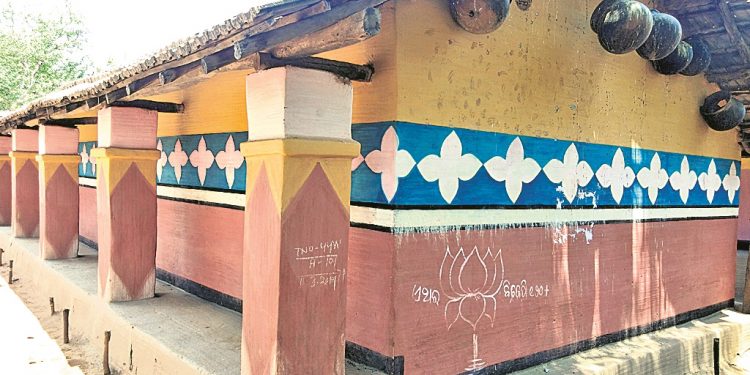Keonjhar: Colourful houses adorned with traditional murals are synonymous with tribal culture of Keonjhar district. These unique colourful tribal paintings in tiny hamlets instantly attract the attention of visitors.
The first time visitors are often seen watching these decorated mud-walled, tile and pantile-roofed houses in awe. Many visitors get selfies clicked with these houses in the backdrop.
That said, the magnitude of labour employed to paint these attractive houses – that are devoid of any sign of modernity is enormous, to say the least.
To begin with, the colours they use are not chemical ones. They usually collect various kinds of clay, stones and leaves from farmlands, hills and jungles. Then, after certain processing, they get the desired colours.
Obvious as it is, the job is a strenuous one. It has become more so nowadays owing to unavailability of select clay, stones and trees. Rapid deforestation and soil erosion have taken their toll as well. The tribals, now need to trek kilometres to get the necessary ingredients to make the colours.
Before doing the murals, they apply layers of colours onto the walls and floors, according to their tradition and belief. One of their family members, who happens to be an expert in mural painting, draws the objects depicting their belief and lifestyle.
Santals, Bhuyans, Mundas, Juangas and several other tribes do have such colourful houses. In fact, the style of painting differentiates them. While the pattern is different from tribe to tribe, they all have common features such as animals, birds, trees, bushes, gods, goddesses, hills and streams.
According to researchers, they still stick to their traditional colours even when the market is glutted with varieties of chemical ones because they know the pros and cons of the natural colours for ages. The natural colours do not do any harm to their skin while painting the murals.
“The tribal people, particularly male ones remain bare-bodied all day through. They often spend their leisure time sitting on the verandahs, resting their backs against the painted walls. When they do so, they usually do not have any fear of getting any harmful effects from the colours they use, unlike the chemical ones,” said a researcher.
According to the tribals, the coats of colours and murals not only make their houses beautiful but also help keep the house cool from inside and help increase its span of life. Moreover, they give a neat and clean look to these houses.
Local researchers believe these murals have the potential to enhance the standard of life of these tribals. Tourists have a penchant for seeing the tribal lifestyle from close quarters. Cashing in on it, if the administration comes up with tourism infrastructure and essential amenities close to these tribal pockets, it would help the district earn revenue and the tribals enhance their financial condition.
That said, in some tribal pockets, along with traditional colours, chemical colours are being used for mural arts. It might just be the beginning of a worrisome trend.
PNN






































